Was a Sacred Curtain (Parokhet) Depicted on Portable Shrines in the Ancient Near East?
Abstract
1. Introduction
2. The Parokhet
3. Archaeological Examples of the Sacred Curtain
4. Depictions of Curtains on Egyptian Sacred Barks
- Cultic processions, when it was taken out of a temple during festivals. In this context, it was carried by a number of priests. A nice example at Karnak from the Red Chapel of Queen Hatshepsut depicts a bark of Amon (Figure 3; Lacau and Chevrier 1977; Karlshausen 1995, pp. 121–22).
- Mortuary ceremonies, when it was laid on a dead king’s sarcophagus and shrine. In this context, the scene is depicted without people. In the chapel of Amen-Re in the temple of Seti in Abydos, numerous barks were depicted, each with a white curtain covering part of the shrine (see, for example, Figure 4; Gardiner 1935, Pl. 5).
5. Sacred Curtains Depicted on Portable Shrines
- Location on the portable shrine: in real life, the textile was hung above the entrance to the Holy of Holies and covered the entrance. On the portable shrines a representation of a curtain should be positioned in the same location, that is above or on the sides of the entrance. Not every ribbon of clay above a door in a pottery portable shrine necessarily represents a curtain, however. In some cases, there is a small narrow ledge above the entrance. On the portable shrine from Kition, where the ledge is supported by two pillars, we have a real portico (Garfinkel and Mumcuoglu 2016, p. 105). In other cases, the ledge is probably a cornice over the door, a horizontal molding that crowns the door and emphasizes it in relation to other parts of the building. Such cornices can be seen on portable shrines from Kamid el-Loz (Echt 1986, p. 116; Muller 2002, pp. 289, 108, Figure 96; Katz 2016, Figure 2.81), Tel Dan (Biran 1994, p. 153, Figure 112; Katz 2016, Figure 2.68), and Hazor (Bechar 2017, Figures 7.126 and 7.130:12). In other words, not every thickening above a door represents a curtain.
- State of the curtain: the door of the portable shrines is open, so that an object symbolizing a divine entity, such as a figurine, could be placed inside. It is clear, in many cases, that this opening was then closed with a door (see, for example, Muller 2016, pp. 155–58). In this situation, the curtain cannot be represented as suspended from above the door, as it would block the opening. Thus, it was necessary to show the curtain as folded away, or to find another iconographic solution. There is a paradox here: how to present both the open door and the curtain that closed it.
- Representing a textile in clay: most of the elements depicted on portable shrines, such as walls, roof, pillars, door, and beams, were made from stone, mudbrick, or wood in real buildings. These are all hard, solid materials. The curtain, on the other hand, was a flexible textile and thus had to be depicted differently from the solid architectural components. Not every rope pattern ribbon represents a textile. However, when cords and ropes are represented on pottery vessels they are relating to the vessel’s handles, as if they were inserted through them (Tadmor 1992; Garfinkel 2019). In the same way, the examples depicted on the portable shrines are all associated with the upper part of the door, and sometimes the lower part as well.
6. Discussion
Author Contributions
Funding
Acknowledgments
Conflicts of Interest
References
- Albertz, Rainer, and Rudiger R. Schmitt. 2012. Family and Household Religion in Ancient Israel and the Levant. Winona Lake: Eisenbrauns. [Google Scholar]
- Bechar, Shlomit. 2017. The Middle and Late Bronze Age Pottery. In Hazor VII. The 1990–2012 Excavations. The Bronze Age. Edited by Amnon Ben-Tor, Sharon Zuckerman, Shlomit Bechar and Débora Sandhaus. Jerusalem: Israel Exploration Society, pp. 199–467. [Google Scholar]
- Biran, Avraham. 1994. Biblical Dan. Jerusalem: Israel Exploration Society and Hebrew Union College. [Google Scholar]
- Bordreuil, Pierre. 2006. Paroket et kapporet. A propos du Saint des Saints en Canaan et en Judée. In Les Espaces Syro-Mésopotamiens: Dimensions de l’Expérience Humaine au Proche-Orient Ancien. Subartu 17. Edited by Pascal Butterlin, Marc Lebeau, Jean-Yves Monchambert, Juan Luis Montero Fenollós and Béatrice Muller. Turnhout: Brepols, pp. 161–68. [Google Scholar]
- Bordreuil, Pierre. 2007. Ugarit and the Bible: New Data from the House of Urtenu. In Ugarit at Seventy-Five. Edited by Lawson K. Younger, Jr. Winona Lake: Eisenbrauns, pp. 89–99. [Google Scholar]
- Bretschneider, Joachim. 1991. Architekturmodelle in Vorderasien und der östlichen Ägäis vom Neolithikum bis in das 1. Jahrtausend. Alter Orient und Altes Testament 229. Kevelaer: Butzon & Bercker. [Google Scholar]
- CAD. 2005. Chicago Assyrian Dictionary. Chicago: Oriental Institute, Chicago: University of Chicago, vol. 12P. [Google Scholar]
- Carter, Howard. 1926. The Tomb of Tut Ankh Amen. London: Cassell, vol. 2. [Google Scholar]
- Carter, Howard. 1933. The Tomb of Tut Ankh Amen. London and Toronto: Cassell, vol. 3. [Google Scholar]
- Carter, Howard, and Alan Gardiner. 1917. The Tomb of Ramesses IV and the Turin Plan of a Royal Tomb. The Journal of Egyptian Archaeology 4: 130–58. [Google Scholar] [CrossRef]
- Carter, Howard, and Arthur C. Mace. 1923. The Tomb of Tut Ankh Amen. London: Cassell, vol. 1. [Google Scholar]
- Chambon, Alain. 1984. Tell El-Far‘ah I: l’Âge du Fer. (Recherche sur les Civilisations 31). Paris: Éditions Recherche sur les Civilisations. [Google Scholar]
- Constas, Nicholas. 2006. Symeon of Thessalonike and the Theology of the Icon Screen. In Thresholds of the Sacred: Architectural, Art Historical, Liturgical, and Theological Perspectives on Religious Screens. Edited by Sharon E. J. Gerstel. Cambridge: Harvard University Press, pp. 163–83. [Google Scholar]
- De Miroschedji, Pierre. 2001. Les ‘maquettes architecturales’ palestiniennes. In Maquettes Architecturales de l’Antiquité, Actes du Colloque de Strasbourg, 3–5 décembre 1998. Travaux du centre de recherche sur le Proche-Orient et la Grèce antique 17. Edited by Béatrice Muller. Paris: Diffusion De Boccard, pp. 43–85. [Google Scholar]
- Du Mesnil du Buisson, Comte Robert. 1939. Les peintures de la synagogue de Doura Europos. Roma: Pontificio Istituto Biblico. [Google Scholar]
- Echt, Rudolf. 1986. Das Hausmodell KL 81:1 und sein kulturgeschichtlicher Kontext. In Bericht über die Ergebnisse der Ausgrabungen in Kāmid el-Lōz 1977 bis 1981. Saarbrücker Beiträge zur Altertumskunde 36. Edited by Rolf Hachmannn. Bonn: Rudolf Habelt Verlag, pp. 101–22. [Google Scholar]
- Elledge, Casey D., and Ehud Netzer. 2015. The Veils of the Second Temple: Architecture and Tradition in the Herodian Sanctuary. Eretz-Israel 32: 40–50. [Google Scholar]
- Falk, David. 2015. Egyptian Barque Shrines and the Complexity of Miniaturized Sacred Spaces. In Meaning and Logos: Proceedings of the Early Professional Interdisciplinary Conference. Edited by Erica Hugues. Cambridge: Cambridge Scholars, pp. 185–94. [Google Scholar]
- Gabbay, Uri. 2014. The kalû Priest and kalûtu Literature in Assyria. Orient 49: 115–44. [Google Scholar] [CrossRef][Green Version]
- Gane, Roy, and Jeremy Milgrom. 2003. Parōket. In Theological Dictionary of the Old Testament Vol. XII. Edited by Johannes G. Botterweck, Helmer Ringgreen and Heinz-Josef Fabry. Grand Rapids: Eerdmans, pp. 95–97. [Google Scholar]
- Gardiner, Alan. 1935. The Temple of King Sethos I at Abydos II: The Chapels of Amen-Re, Re-Harakhti, Ptah and King Sethos. London: Egypt Exploration Society. [Google Scholar]
- Garfinkel, Yosef. 2018. Chasing Away Lions and Weaving: The longue durée of Talmudic Gender Icons. In Sources and Interpretation in Ancient Judaism. Studies for Tal Ilan at Sixty. Edited by Meron N. Piotrkowski, Geoffrey Herman and Saskia Dönitz. Leiden: Brill, pp. 11–31. [Google Scholar]
- Garfinkel, Yosef. 2019. The Incised Decoration of the Yarmukian Culture. In Sha’ar Hagolan Vol. 5. Early Pyrotechnology: Ceramic and White Ware (Qedem Reports 14). Edited by Yosef Garfinkel. Jerusalem: Institute of Archaeology, Hebrew University, pp. 139–67. [Google Scholar]
- Garfinkel, Yosef, and Madeleine Mumcuoglu. 2013. Triglyphs and Recessed Doorframes on a Building Model from Khirbet Qeiyafa: New Light on Two Technical Terms in the Biblical Descriptions of Solomon’s Palace and Temple. Israel Exploration Journal 63: 135–63. [Google Scholar]
- Garfinkel, Yosef, and Madeleine Mumcuoglu. 2015. A Shrine Model from Tel Rekhesh. Strata: Bulletin of the Anglo-Israeli Archaeological Society 33: 77–87. [Google Scholar]
- Garfinkel, Yosef, and Madeleine Mumcuoglu. 2016. Solomon’s Temple and Palace: New Archaeological Discoveries. Jerusalem: Bible Lands Museum Jerusalem and Biblical Archaeology Society. [Google Scholar]
- Garfinkel, Yosef, and Madeleine Mumcuoglu. 2018. An Elaborate Clay Portable Shrine. In Khirbet Qeiyafa Vol. 4, Excavation Report 2009–2013: Art, Cult and Epigraphy. Edited by Yosef Garfinkel, Saar Ganor and Michael G. Hasel. Jerusalem: Israel Exploration Society, pp. 83–100. [Google Scholar]
- George, Andrew. 1992. Babylonian Topographical Texts. Orientalia Lovaniensia Analecta 40. Leuven: Peeters. [Google Scholar]
- Gespa, Salvatore. 2018. Textiles in the Neo Assyrian Empire: A Study of Terminology. Berlin: De Gruyter. [Google Scholar]
- Giveon, Raphael. 1978. The Impact of Egypt on Canaan: Iconographical and Related Studies. Orbis Biblicus et Orientalis 20. Freiburg: Universitätsverlag. Gottingen: Vandenhoeck & Ruprecht. [Google Scholar]
- Givon, Shmuel. 2008. Harasim, Tel. In The New Encyclopedia of Archaeological Excavations in the Holy Land. Edited by Ephraim Stern. Jerusalem: Israel Exploration Society, vol. 5, pp. 1766–67. [Google Scholar]
- Gurtner, Daniel M. 2006. The Veil of the Temple in History and Legend. Journal of the Evangelical Theological Society 49: 97–114. [Google Scholar]
- Ilan, Tal. 2017. The Plundering of the Temple Utensils. In Josephus and the Rabbis. Edited by Tal Ilan and Vered Noam. Jerusalem: Yad Ben-Zvi, pp. 822–33. (In Hebrew) [Google Scholar]
- Karlshausen, Christina. 1995. L’évolution de la barque processionnelle d’Amon à la 18e Dynastie. Revue d’Egyptologie 46: 119–37. [Google Scholar] [CrossRef]
- Katz, Hava. 2016. Portable Shrine Models. Ancient Architectural Clay Models from the Levant. BAR International Series 2791; Oxford: British Archaeological Reports. [Google Scholar]
- Keel, Othmar. 1998. Goddesses and Trees, New Moon and Yahweh: Ancient Near Eastern Art and the Hebrew Bible. JSOT Supplement 261. Sheffield: Sheffield University Press. [Google Scholar]
- Kletter, Raz. 2004. Clay Figurines. In The Renewed Archaeological Excavations at Lachish: Vol. III. Edited by David Ussishkin. Tel Aviv: Institute of Archaeology, Tel Aviv University, pp. 1572–83. [Google Scholar]
- Kletter, Raz, Irit Ziffer, and Wolfgang Zwickel. 2010. Yavneh I: The Excavation of the ‘Temple Hill’ Repository Pit and the Cult Stands. Orbis Biblicus et Orientalis. Series Archaeologica 30; Fribourg: Academic Press. Göttingen: Vandenhoeck & Ruprecht. [Google Scholar]
- Kraeling, Carl-Hermann. 1979. The Synagogue. Excavations at Dura Europos Final Report VII. New Haven: Yale University Press. [Google Scholar]
- Lacau, Pierre, and Henri Chevrier. 1977. Une chapelle d’Hatshepsout à Karnak. Cairo: Institut français d’archéologie orientale du Caire, vol. 1. [Google Scholar]
- Lidov, Alexei. 2014. The Temple Veil as a Spatial Icon. Revealing an Image-Paradigm of Medieval Iconography and Hierotopy. Ikon 7: 97–108. [Google Scholar] [CrossRef]
- Mariette, Auguste. 1880. Catalogue Général des Monuments d’Abydos Découverts Pendant les Fouilles de Cette Ville. Paris: Imprimerie Nationale. [Google Scholar]
- May, Natalie N. 2013. Gates and their Functions in Mesopotamia and Ancient Israel. In The Fabric of Cities: Aspects of Urbanism, Urban Topography and Society in Mesopotamia, Greece and Rome. Edited by Natalie N. May and Ulrike Steinert. Leiden: Brill, pp. 77–121. [Google Scholar]
- Mazar, Amihai. 1980. Excavations at Tell Qasile Vol. 1. The Philistine Sanctuary: Architecture and Cult Objects. Qedem 12. Jerusalem: Institute of Archaeology, Hebrew University of Jerusalem. [Google Scholar]
- Mazar, Amihai, and Nava Panitz-Cohen. 2008. To What God? Altars and a House Shrine from Tel Rehov Puzzle Archaeologists. Biblical Archaeology Review 34: 40–47. [Google Scholar]
- Megahed, Ibrahim, and Hussein Bassir. 2015. The Clay Naos of the Goldsmith Sankhuher in the Egyptian Museum in Cairo. Cahiers caribéens d’Egyptologie 19–20: 143–60. [Google Scholar]
- Menzel, Brigitte. 1981. Assyrische Tempel. Untersuchungen zu Kult, Administration und Personal. Studia Pohl, Series Maior 10; Rome: Pontifical Institute Press. [Google Scholar]
- Metzger, Martin. 1993. Kamid el-Loz VIII. Die Spätbronzezeitlichen Tempelanlagen. Die Kleinfunde. Bonn: R. Habelt. [Google Scholar]
- Moscati, Sabatino. 1988. The Phoenicians. Milan: Bompiani. [Google Scholar]
- Muller, Béatrice. 2002. Les “maquettes architecturales” du Proche Orient ancien. Mésopotamie, Syrie, Palestine du IIIe au milieu du 1er millénaire av. J.-C. Bibliothèque archéologique et historique 160. Beirut: Institut français d’archéologie du Proche-Orient. [Google Scholar]
- Muller, Béatrice. 2016. Maquettes Antiques d’Orient de L’image D’architecture au Symbole. Paris: Picard. [Google Scholar]
- Mumcuoglu, Madeleine, and Yosef Garfinkel. 2020. Gate Piazza and Cult at Iron Age IIA at Tell el-Far‘ah North. Revue Biblique 127: 105–29. [Google Scholar]
- Noegel, Scott B. 2015. The Egyptian Origin of the Ark of the Covenant. In Israel’s Exodus in Transdisciplinary Perspective. Text, Archaeology, Culture, and Geoscience. Edited by Thomas E. Levy, Thomas Schneider and William H. C. Propp. Heidelberg: Springer, pp. 223–42. [Google Scholar]
- Roeder, Günther. 1914. Catalogue Général des Antiquités Égyptiennes. Leipzig: Breitkopf and Härtel. [Google Scholar]
- Rosenthal-Heginbottom, Renate. 2009. The Curtain (parochet) in Jewish and Samaritan Synagogues. In Clothing the House. Furnishing Textiles of the 1rst Millennium AD from Egypt and Neighbouring Countries, Proceedings of the 5th Conference of the Research Group ‘Textiles from the Nile Valley’ Antwerp, 6–7 October 2007. Edited by Antoine De Moor, Cäcilia Fluck and Susanne Martinssen-von Falck. Tielt: Lannoo, pp. 155–69. [Google Scholar]
- Rowe, Alan. 1940. The Four Canaanite Temples of Beth-Shan. Philadelphia: University of Pennsylvania Press. [Google Scholar]
- Schattner-Rieser, Ursula. 2012. Les empreintes bibliques et emprunts Juifs dans la culture éthiopienne. Journal of Eastern Christian Studies 64: 5–28. [Google Scholar]
- Schroer, Silvia. 2011. Die Ikonographie Palästinas/Israels und der Alte Orient, Vol. 3: Die Spätbronzezeit. Fribourg: Academic Press. [Google Scholar]
- Stager, E. Lawrence. 2008. The Canaanite Silver Calf. In Ashkelon 1. Introduction and Overview (1985–2006). Edited by Lawrence E. Stager, David J. Schloen and Daniel M. Master. Winona Lake: Eisenbrauns, pp. 577–80. [Google Scholar]
- Tadmor, Miriam. 1992. On Lids and Rope in the Early Bronze and Chalcolithic Periods. Eretz-Israel 22: 82–91. (In Hebrew). [Google Scholar]
- Tadmor, Miriam. 1996. Plaque Figurines of Recumbent Women—Use and Meaning. Eretz-Israel 25: 290–96. (In Hebrew). [Google Scholar]
- Ussishkin, David. 1982. The Conquest of Lachish by Sennacherib. Tel Aviv: Institute of Archaeology, Tel Aviv University. [Google Scholar]
- Van der Meulen, Faber. 1985. One or Two Veils in Front of the Holy of Holies? Theologia Evangelica 18: 22–27. [Google Scholar]
- Villard, Pierre. 2010. Les textiles Néo-Assyriens et leurs couleurs. In Textile Terminologies in the Ancient Near East and Mediterranean from the Third to the First Millennia BC. Edited by Cécile Michel and Marie-Louise Nosch. Oxford: Oxbow Books, pp. 388–99. [Google Scholar]
- Weinberg, Saul. 1978. A Moabite Shrine Group. Muse: Annual of the Museum of Art and Archaeology, University of Missouri–Columbia 12: 30–48. [Google Scholar]
- Weissbein, Itamar, Yosef Garfinkel, Michael G. Hasel, and Martin G. Klingbeil. 2016. Goddesses from Canaanite Lachish. Strata: Bulletin of the Anglo-Israeli Archaeological Society 34: 41–55. [Google Scholar]
- Woolley, Leonard, and Max Mallowan. 1976. The Old Babylonian Period. Ur Excavations 7. London: British Museum. [Google Scholar]
- Yadin, Yigael. 1983. The Temple Scroll. Jerusalem: Israel Exploration Society. [Google Scholar]
- Yaniv, Bracha. 2019. Ceremonial Synagogue Textiles. London: Littman Library of Jewish Civilization. [Google Scholar]
- Yon, Marguerite, and Daniel Arnaud. 2001. Etudes Ougaritiques I. Travaux 1985–1995. Ras Shamra-Ougarit XIV. Paris: Publications de la Mission Archéologique Française de Ras Shamra-Ougarit. [Google Scholar]
- Zevit, Ziony. 2001. The Religions of Ancient Israel: A Synthesis of Parallactic Approaches. London: Continuum. [Google Scholar]
- Zori, Nehamia. 1977. The Land of Issachar. Archaeological Survey of Mount Gilboa and its Slopes, the Jezreel Valley and Eastern Lower Galilee. Jerusalem: Israel Exploration Society. (In Hebrew) [Google Scholar]
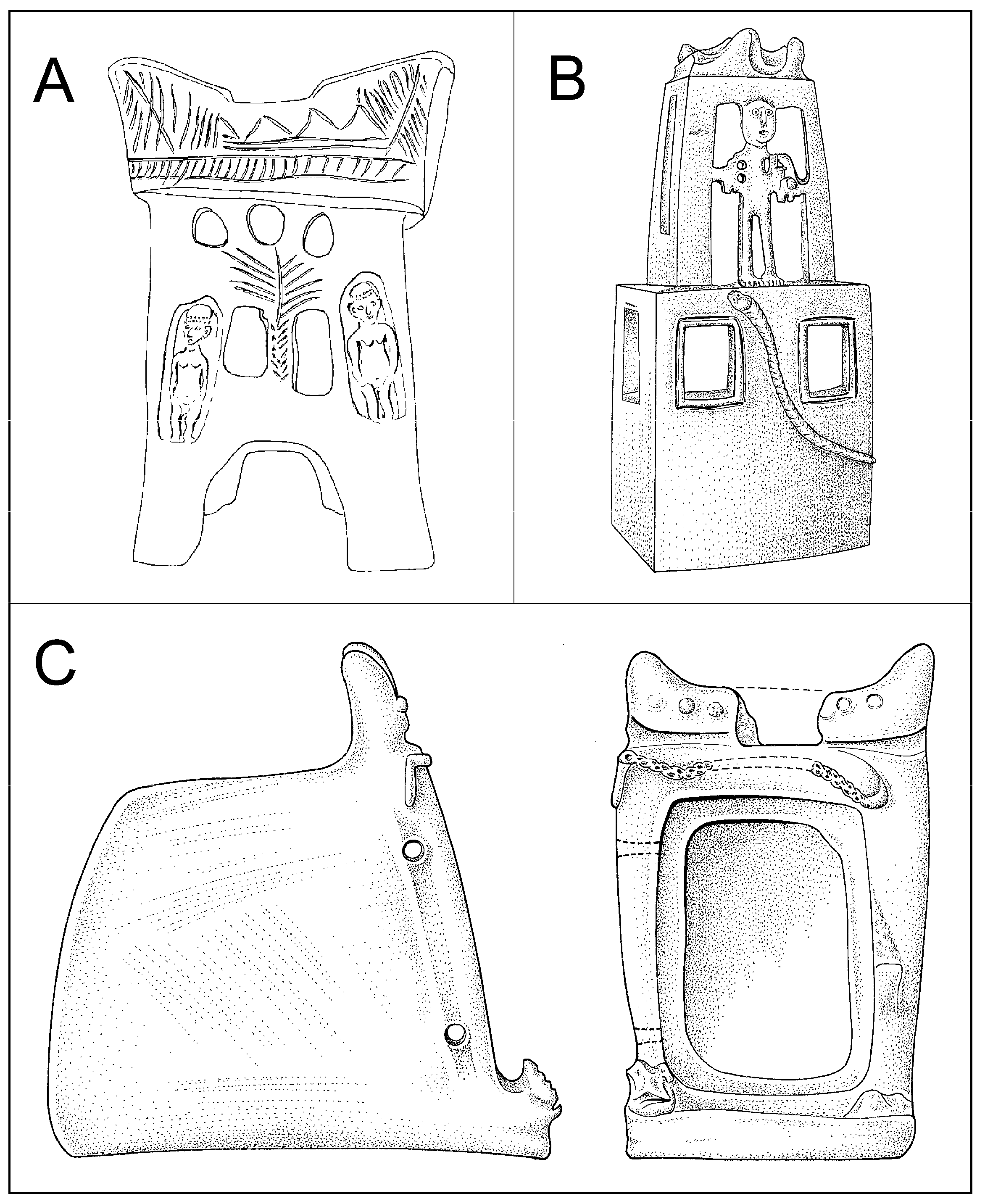
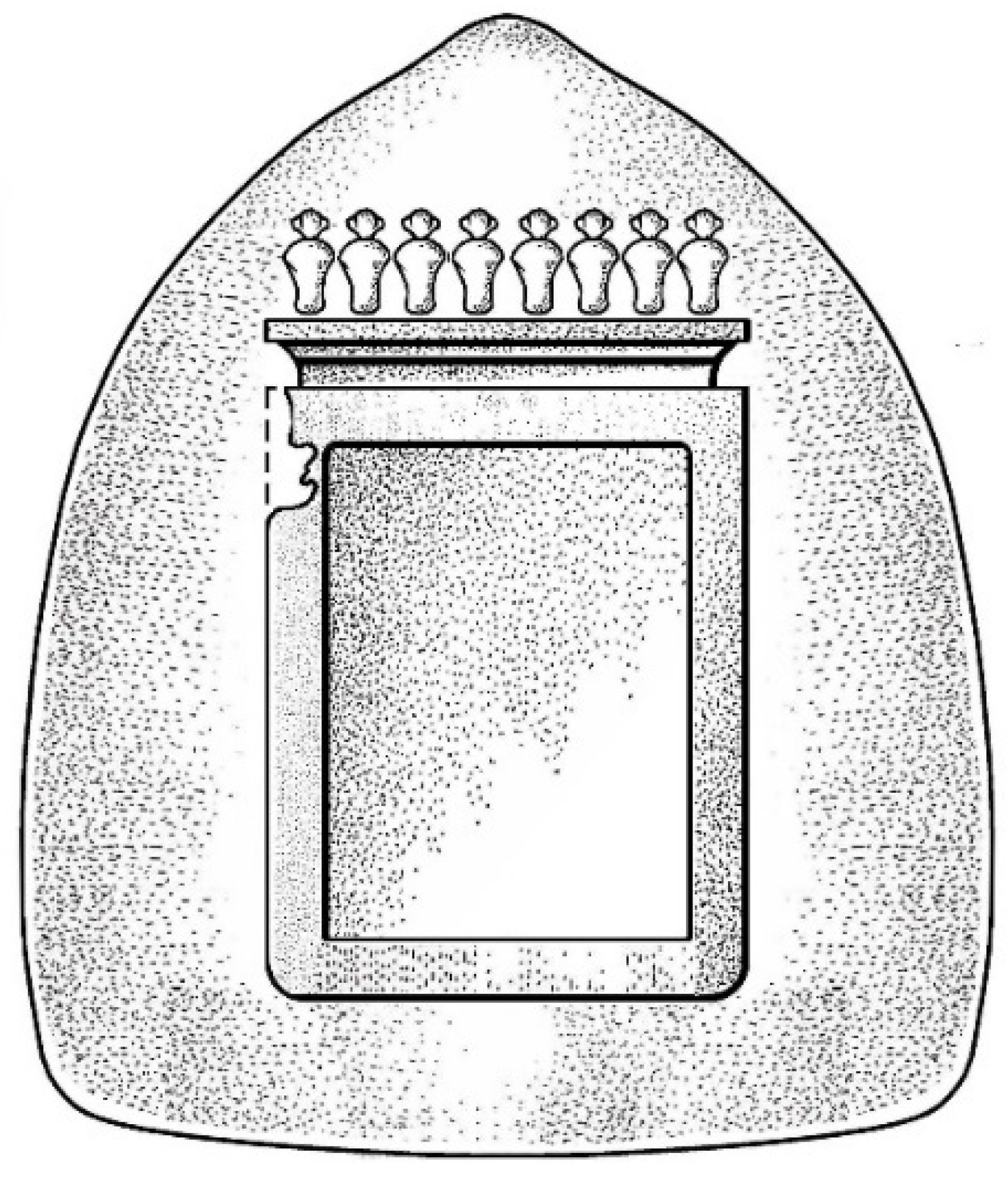
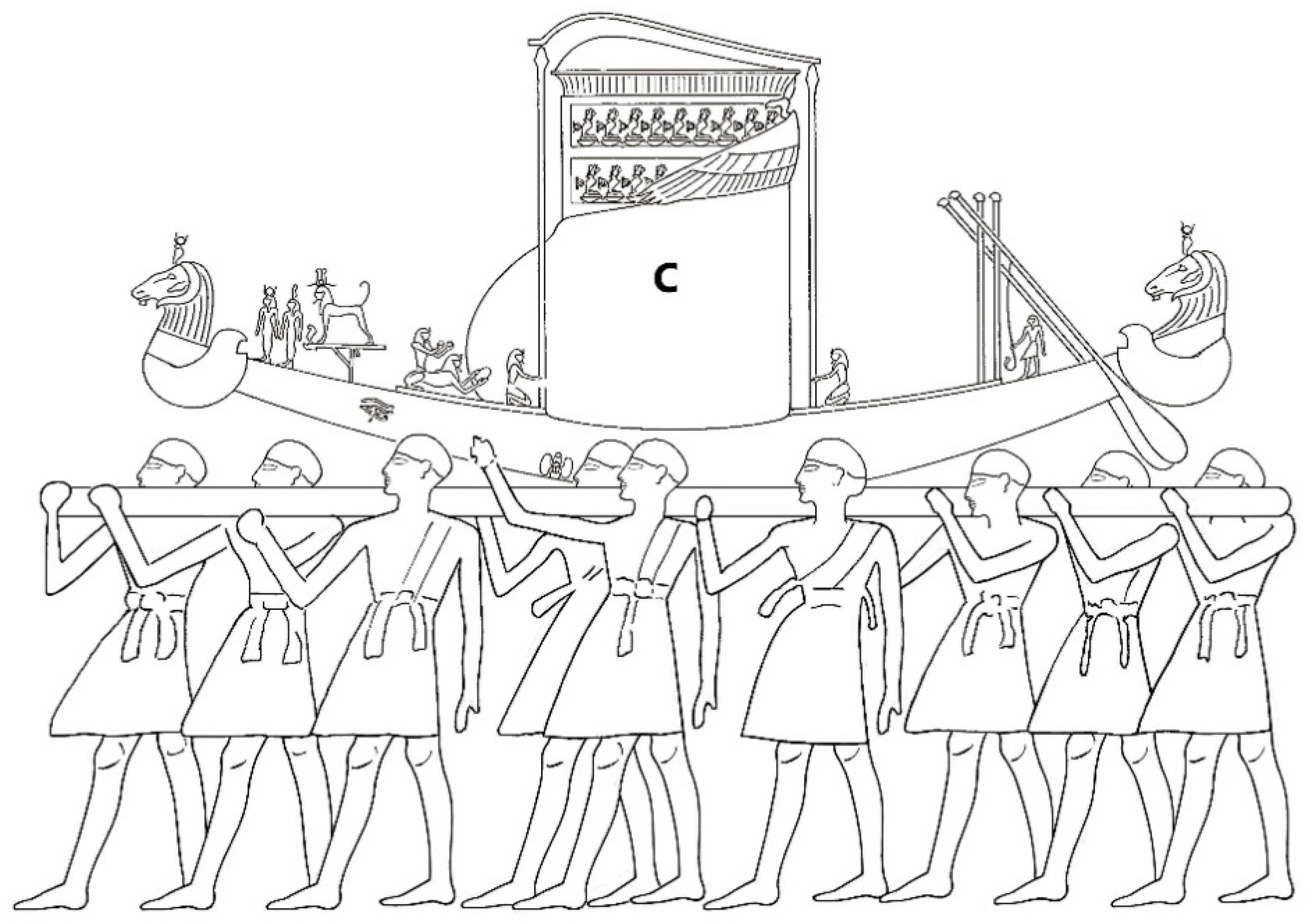
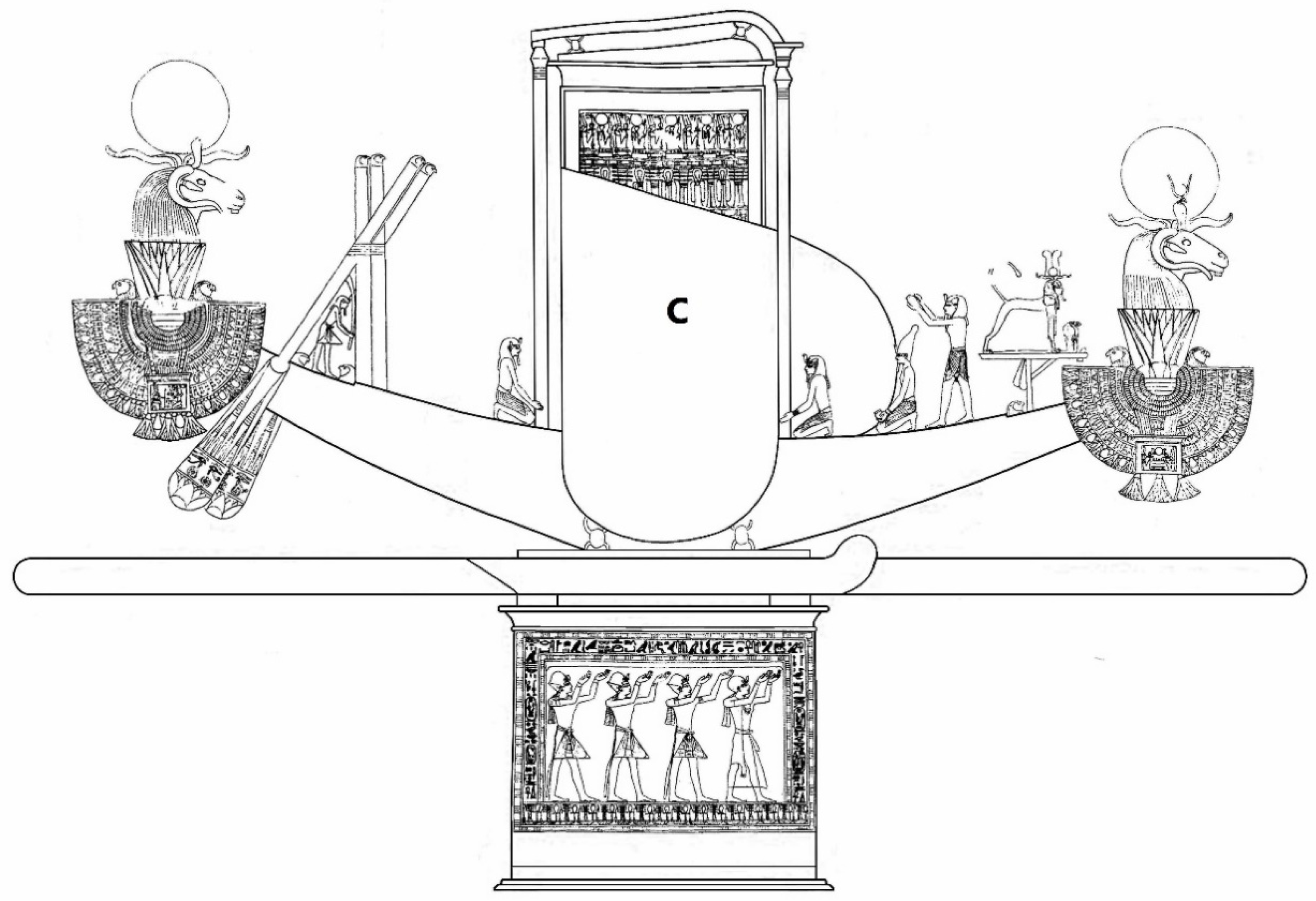
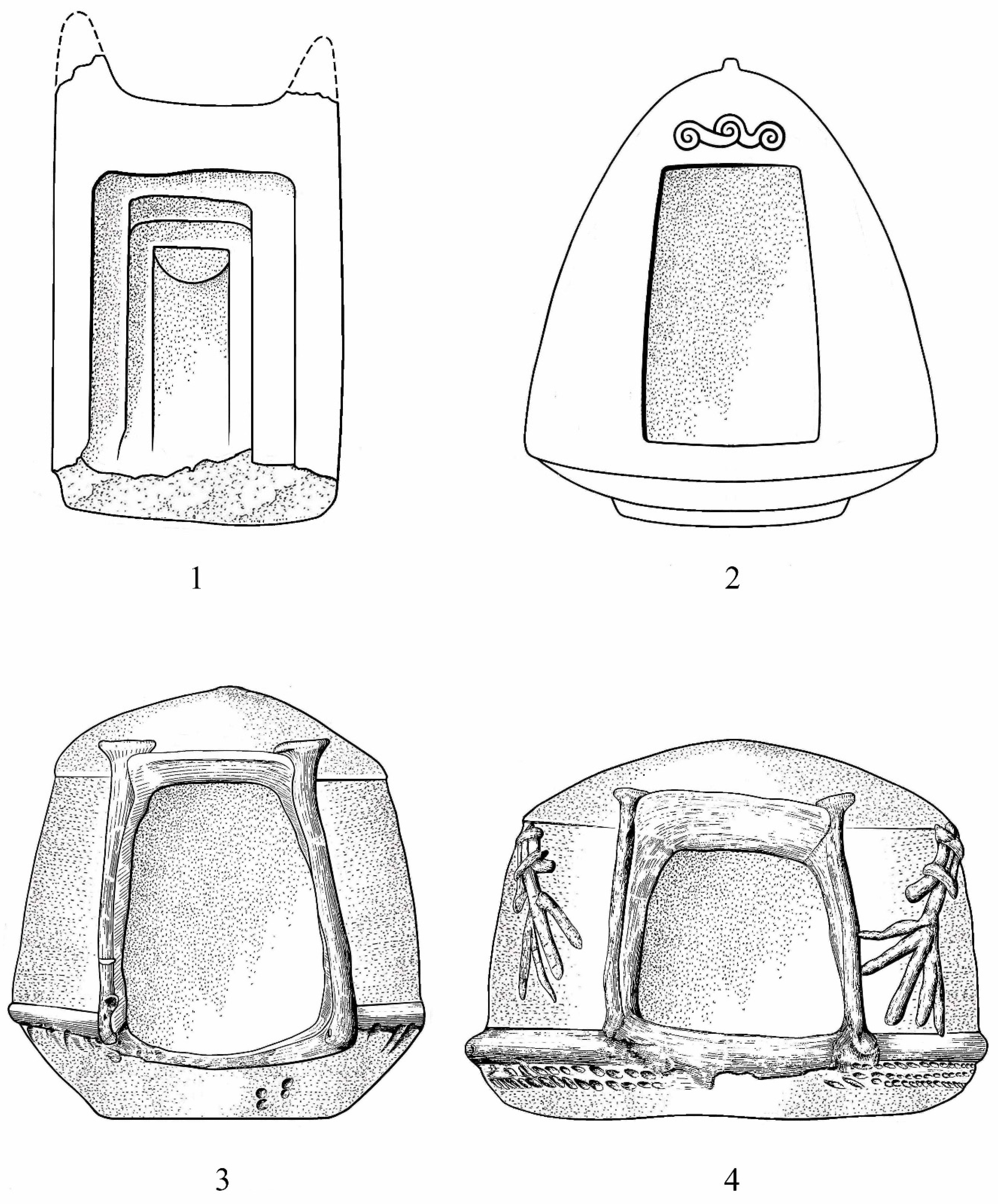
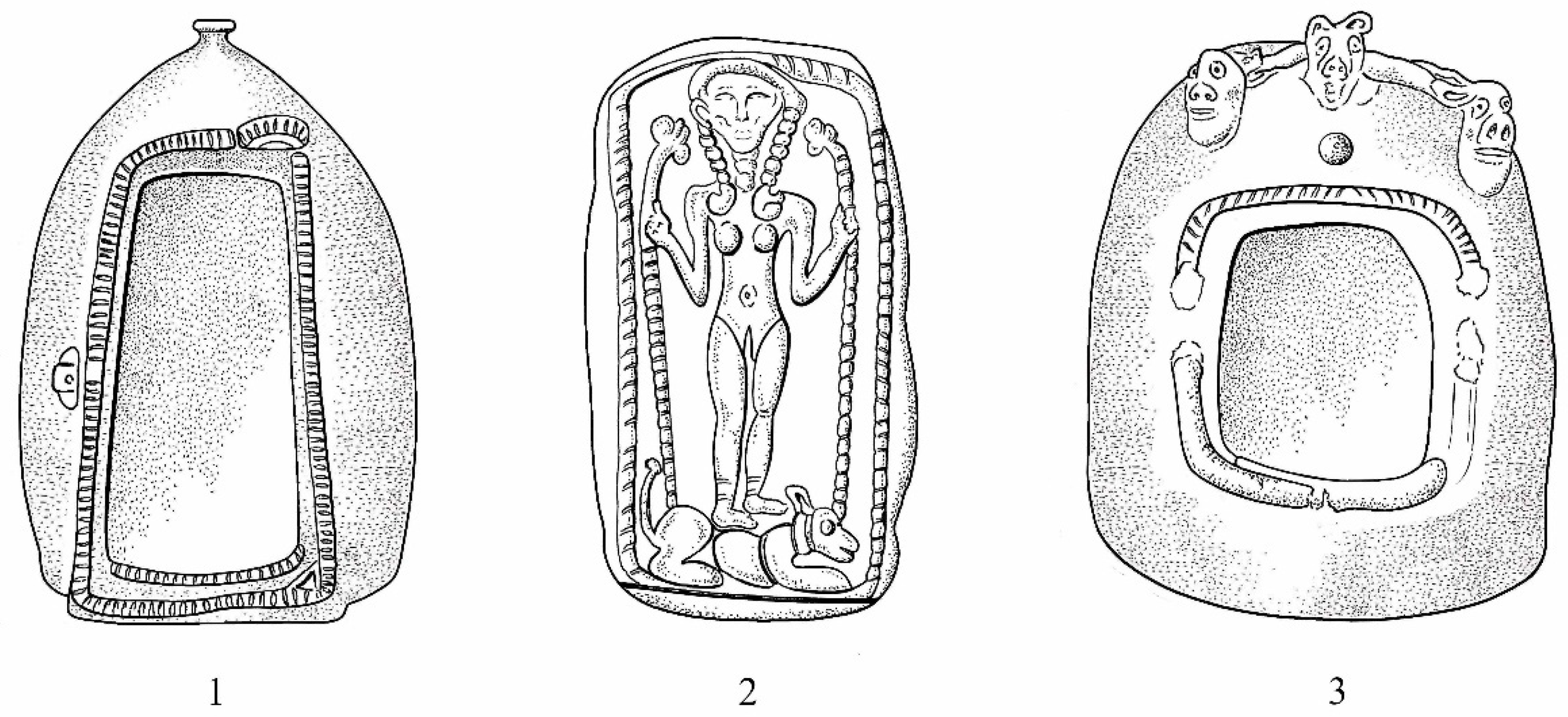
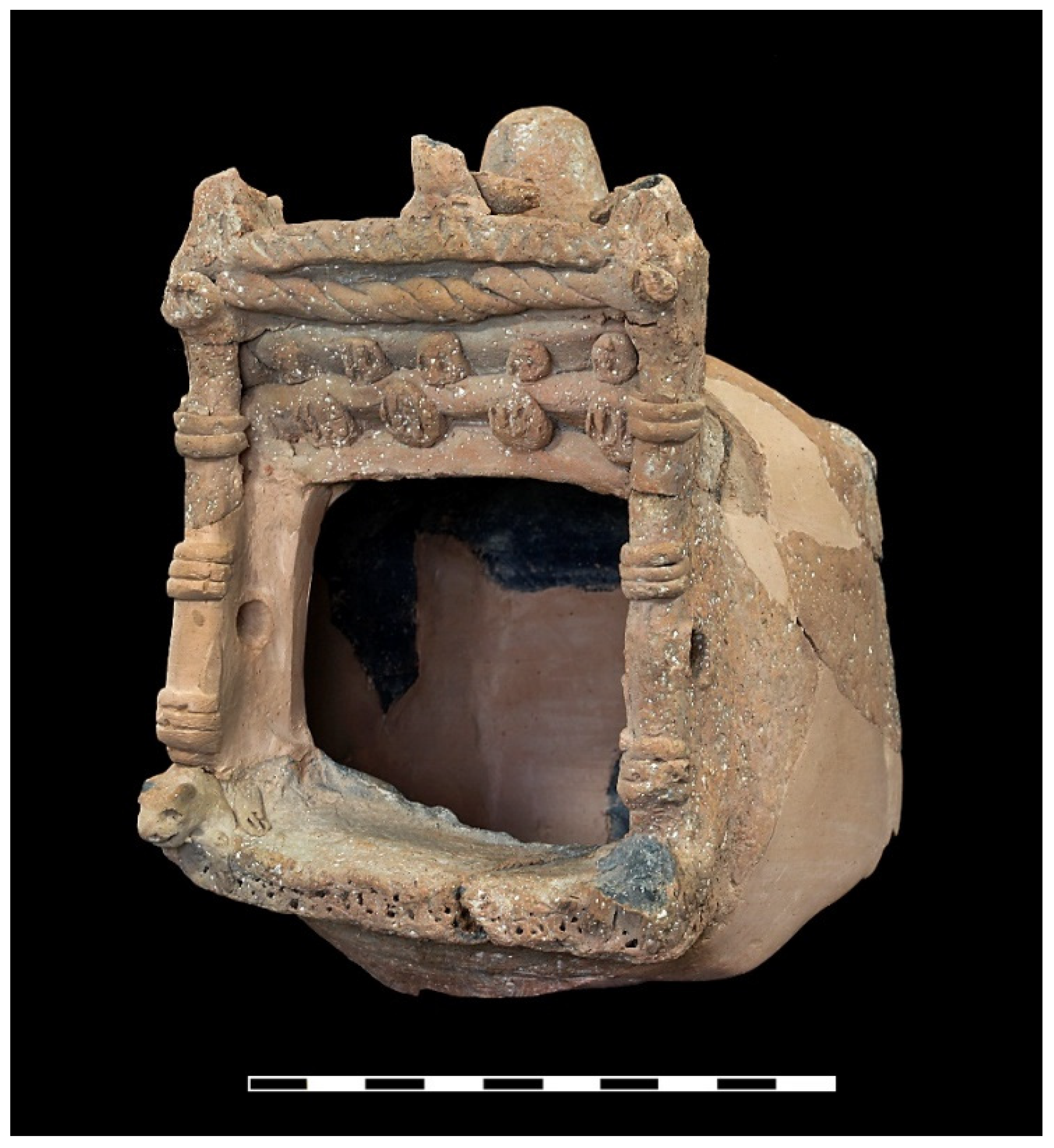
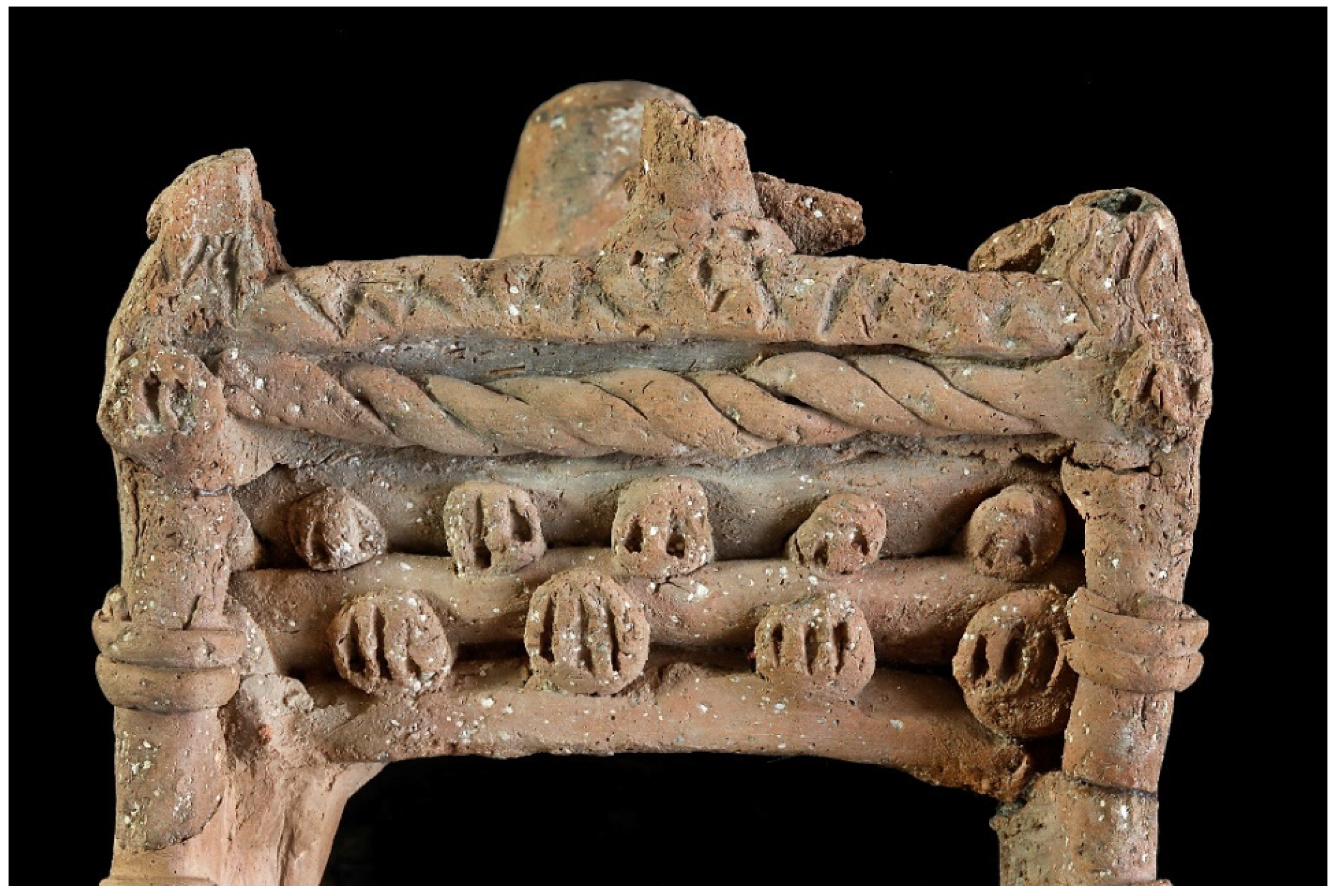
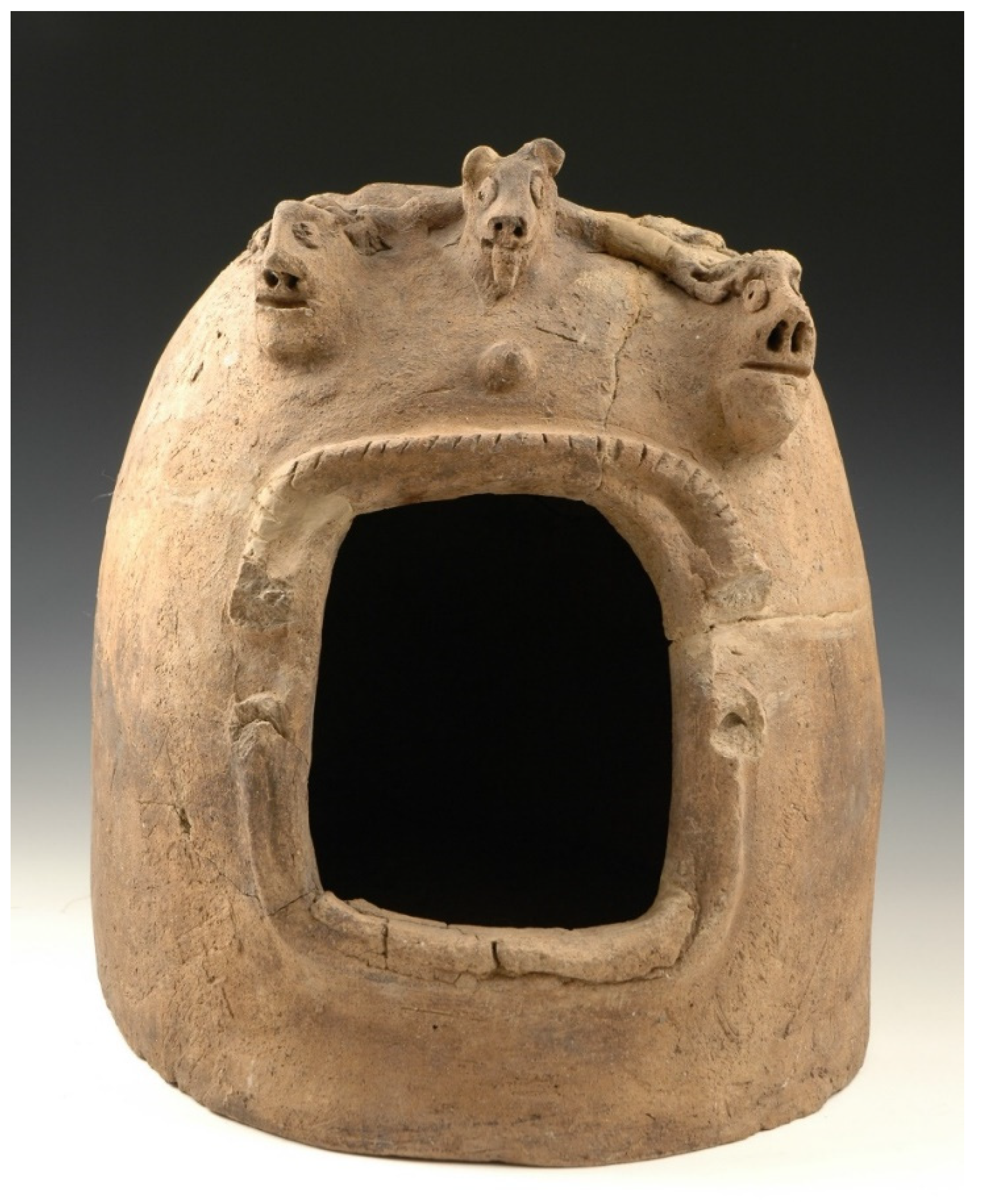
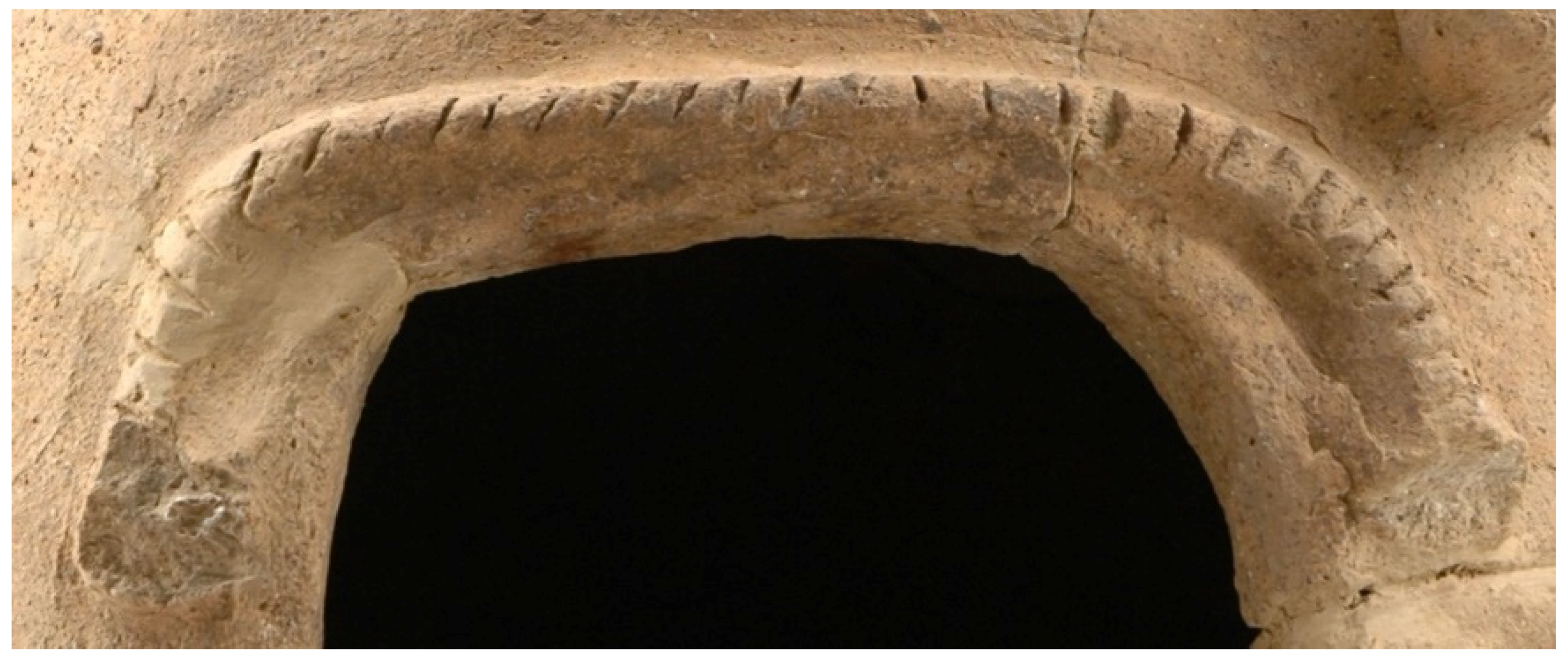
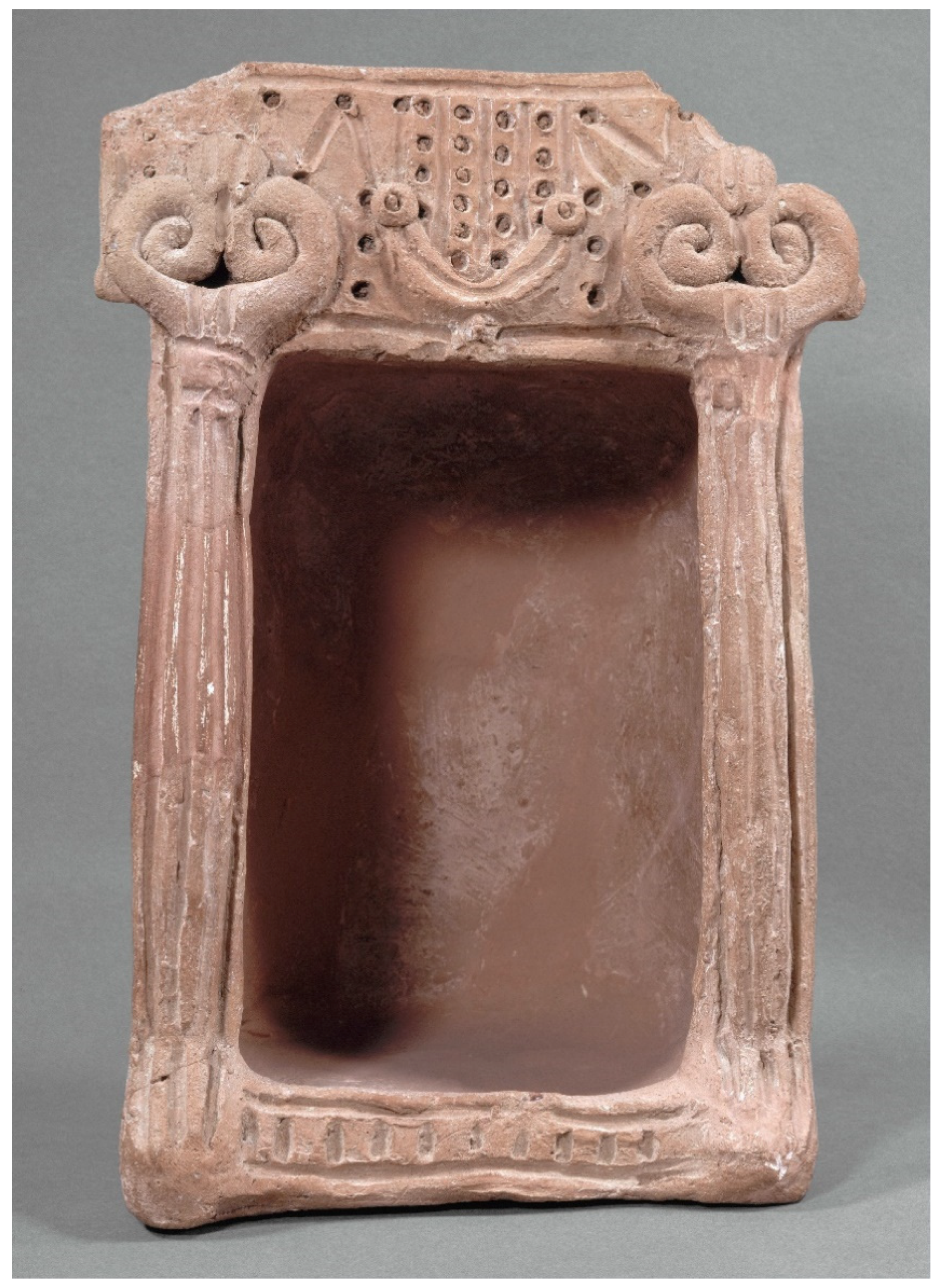
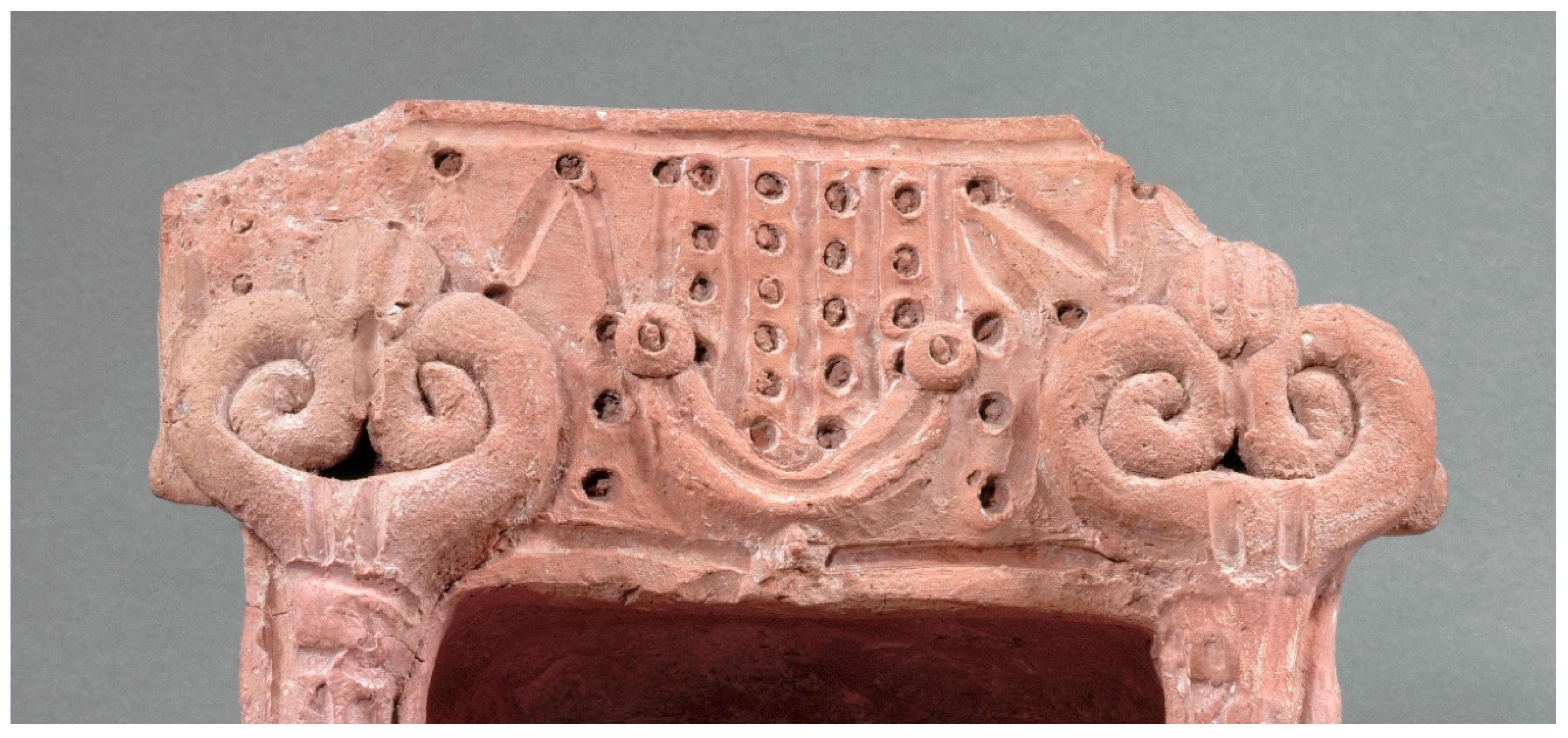
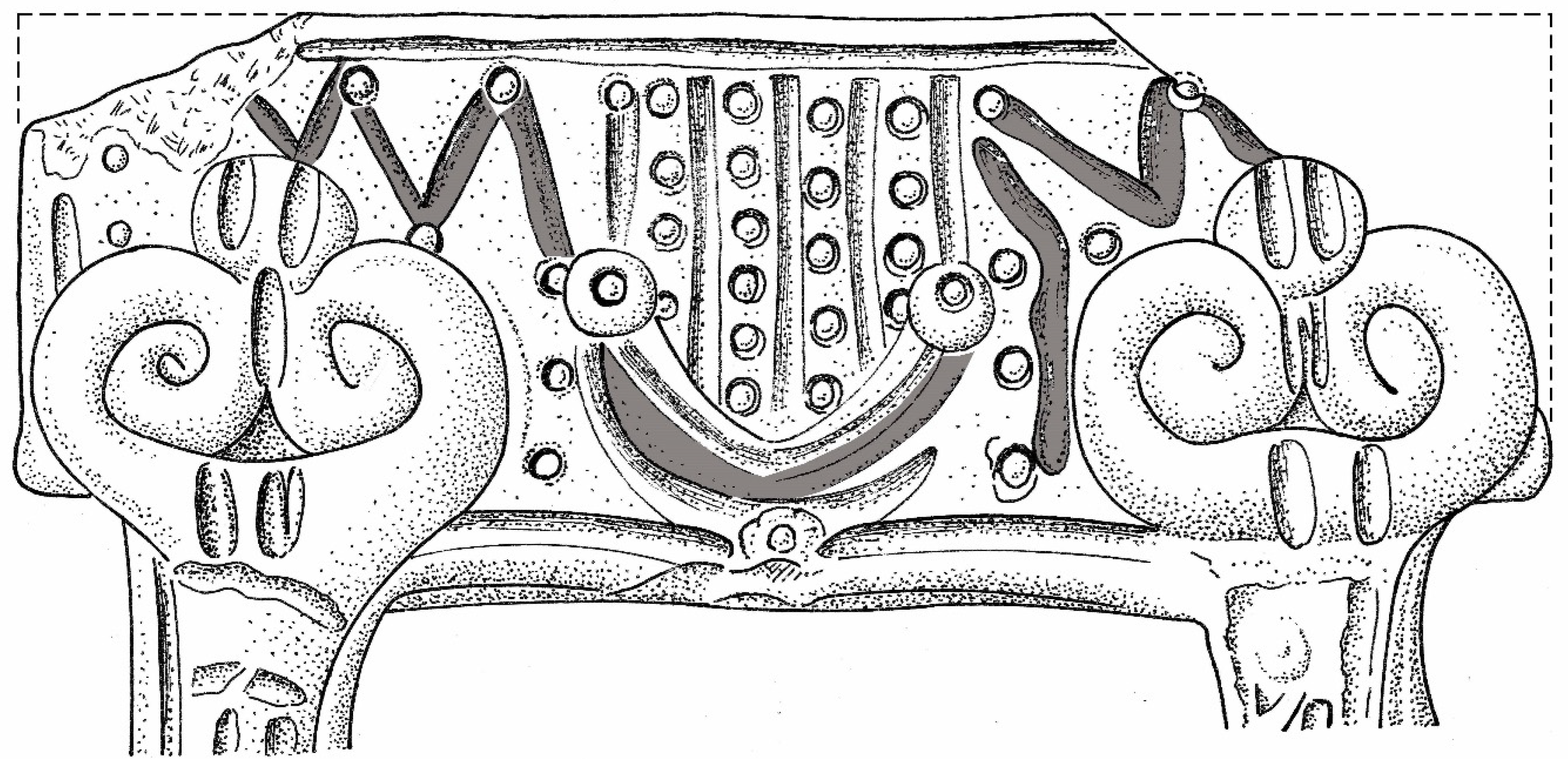

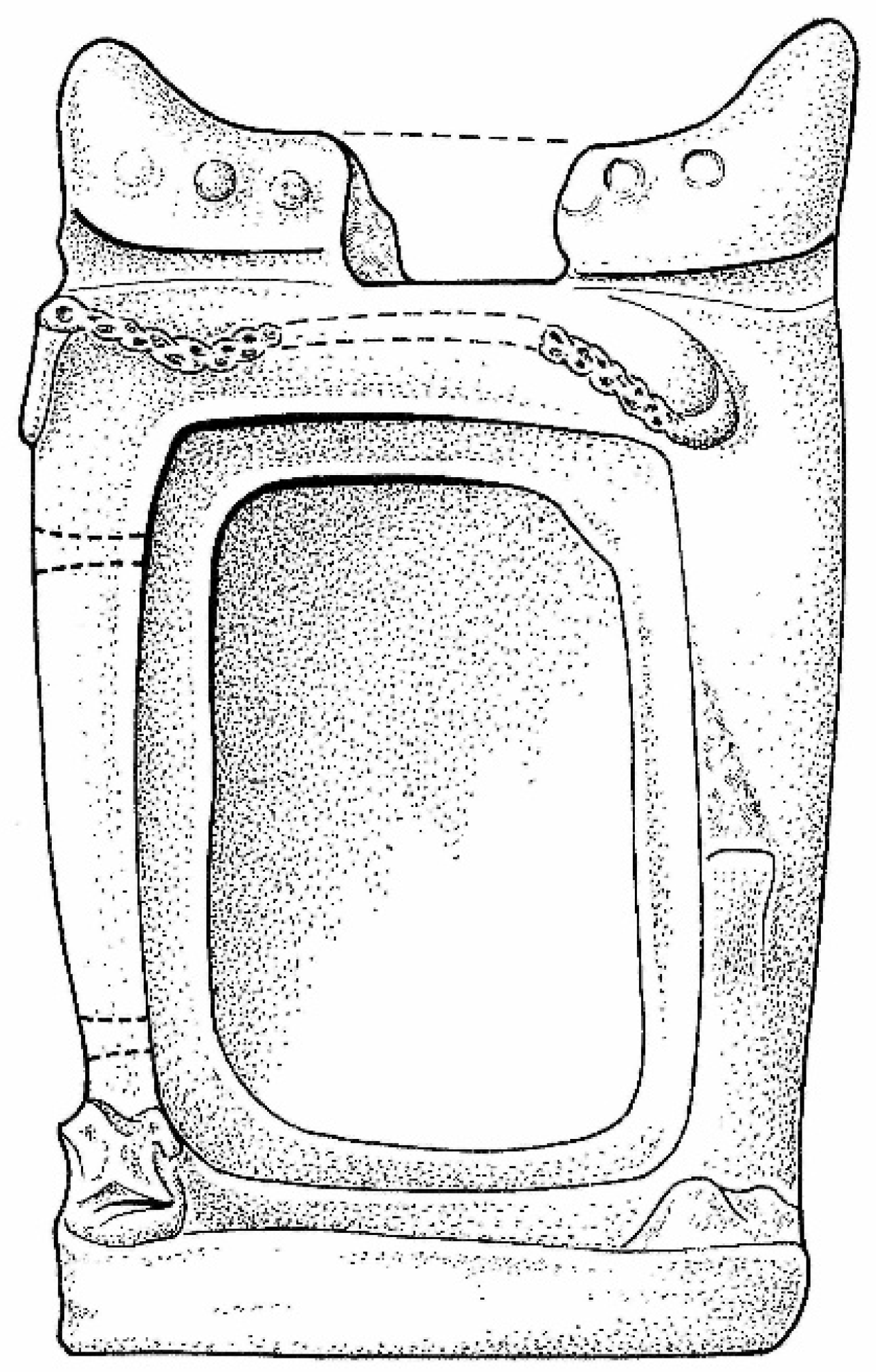
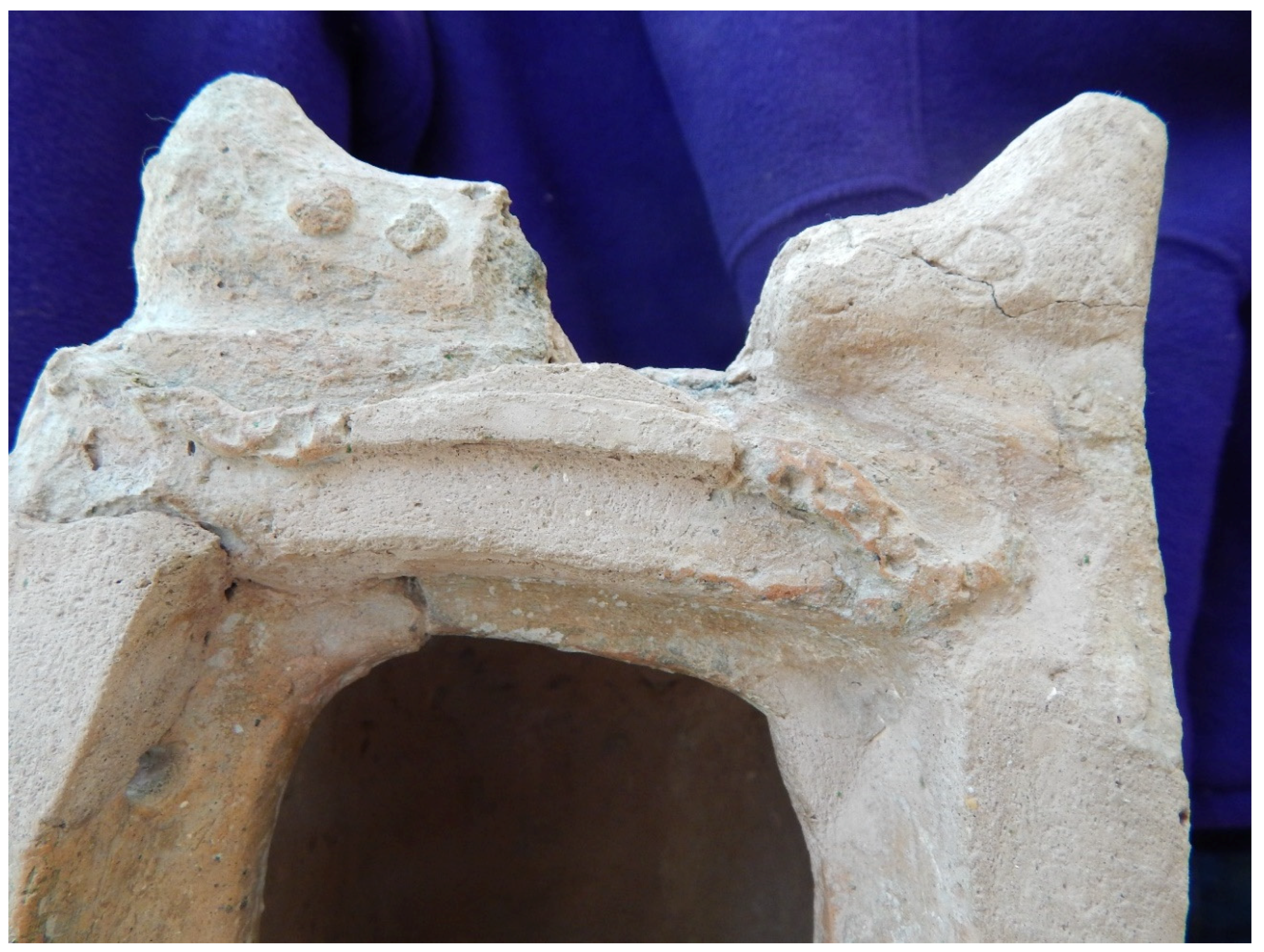
© 2020 by the authors. Licensee MDPI, Basel, Switzerland. This article is an open access article distributed under the terms and conditions of the Creative Commons Attribution (CC BY) license (http://creativecommons.org/licenses/by/4.0/).
Share and Cite
Mumcuoglu, M.; Garfinkel, Y. Was a Sacred Curtain (Parokhet) Depicted on Portable Shrines in the Ancient Near East? Religions 2020, 11, 469. https://doi.org/10.3390/rel11090469
Mumcuoglu M, Garfinkel Y. Was a Sacred Curtain (Parokhet) Depicted on Portable Shrines in the Ancient Near East? Religions. 2020; 11(9):469. https://doi.org/10.3390/rel11090469
Chicago/Turabian StyleMumcuoglu, Madeleine, and Yosef Garfinkel. 2020. "Was a Sacred Curtain (Parokhet) Depicted on Portable Shrines in the Ancient Near East?" Religions 11, no. 9: 469. https://doi.org/10.3390/rel11090469
APA StyleMumcuoglu, M., & Garfinkel, Y. (2020). Was a Sacred Curtain (Parokhet) Depicted on Portable Shrines in the Ancient Near East? Religions, 11(9), 469. https://doi.org/10.3390/rel11090469




